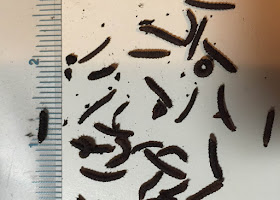By Beth
Sullivan
As we
have now come to the end of 2015, it is time to look back, as we
always do, and review. It is time to recollect high points,
accomplishments and also think of what we could have done better.
And then set goals for the New Year.
Some of
our goals are small and personal, some reach a bit farther into the
landscape or community, and some can be global. Well, maybe a drop
in the global bucket.
 |
| 1. The stone wall along both sides of North Main Street around Fennerswood Preserve, have been restored. |
One of
my goals was to get out on all of Avalonia’s trailed properties to
explore, photograph and then write about them and share with others.
I did OK on those that were closest to home, but still need to reach
farther into our northern towns to seek out a few special gems. I
will make that a goal for 2016 and let you know!
 |
| 2. Dodge Paddock is slowly returning to a very special tidal habitat. Photograph by Roger Wolfe, DEEP. |
Into the woods
We
ended up with a bigger effort to do complete boundary surveys on all
of our properties, so that took me deeper into the untrailed areas,
wetlands and thickets. Not always easy, but certainly an adventure.
I am left with a better understanding of the properties we hold and
need to steward: Beautiful and varied. Some of great value for
wildlife, some of greater value for the opportunities they provide
for people of all ages to explore. I have a greater appreciation
for our local stewards who adopt a property and help keep roadsides
cleaned up, walls maintained, invasives cut and trails opened. As
always, I thank you.
 |
| 3. The young forest is growing a Peck Preserve and the power line provides a New England Cotton-tail bunny trail. |
Some of
our projects have far reaching effects. The biggest undertaking this
year was the restoration of Dodge Paddock. With support, funding,
grants and generosity, the lovely area is well on its way to
becoming the little jewel in the Borough it used to be. Not the same
as it was historically, but adaptive to the changes and challenges
that recent years have tossed at it, and the future certainly holds.
The community around the Paddock will benefit by witnessing
increased wildlife, native habitat and hopefully, less severe
flooding impacts. The benefits reach even farther as local groups
continue to study our efforts and results as a model for other
projects. There will be opportunities for numerous student groups,
from elementary age to college and beyond, to study there. We have
come a long way, and still have more to do.
 |
| 4. We ourselves may not be able to save a rain forest. |
New England Cottontail habitat restoration
As a
result of widespread efforts in the North East, The New England
Cottontail was kept off the endangered species list. Keeping a
species OFF the list is always the goal, as it is ever so much easier
to work in the landscape before a species is in such decline that the
most extreme measures must be taken to preserve it. The project on
our Peck & Callahan Preserves, begun in 2012, has been deemed a
success on many levels and contributed to the total acreage needed in
the focus areas to provide vital habitat for the Cottontails.
 |
| 5. We can work together to preserve forest land in our community. |
Overall
this year, Avalonia Land Conservancy added preserves and acreage to
its protected holdings. There are more acquisitions being reviewed
and priorities set. In a recent article in the New London Day, and
a subsequent editorial, conservation efforts got a big boost by
publicly proclaiming the absolute importance of preserving forest
land. Not only in our own communities, for our personal health and
well-being, but globally. Whether it is one acre of rain forest in
Cost Rica, or a forest preserve like those Avalonia protects here
in our corner of Connecticut, it is essential to life on our planet
that we recognize the importance of preservation.
 |
| 6. Some local preserved habitats are rare like Bell Cedar Swamp |
It is
something we all can support, where we can make a difference and have
an impact, if we work together. A good goal for 2016.
 |
| 7. Sometimes we just need a simple place to absorb the importance of the nature around us. |
Happy
New Year!
Photographs
by Beth Sullivan unless otherwise indicated.










































